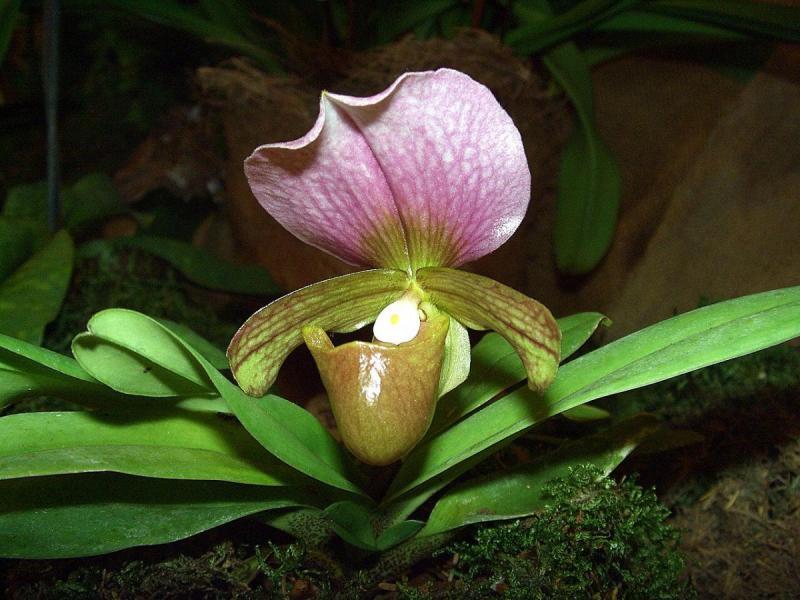Paphiopedilum charlesworthii
Also known as: The Charlesworth Paphiopedilum or Paphiopedilum charlesworthii f. crawshayae Paphiopedilum charlesworthii h.f. semialbum Paphiopedilum charlesworthii h.f. tipo Paphiopedilum charlesworthii h.f. album-sandowiae Paphiopedilum charlesworthii h.f. album Paphiopedilum charlesworthii marginata Paphiopedilum charlesworthii f. sandowiae Cypripedium crawshayae in the subfamily: Cypripedioideae
Native to: China Myanmar Thailand
General Information
The Charlesworth Paphiopedilum is a sympodial cool to warm growing epiphytic orchid belonging to the sub family Cypripedioideae native to China, Myanmar and Thailand. It is named after the English Orchid Nursery.
Plant Description
Sympodial. Grows to 25cm. Each new growth has numerous leaves that grow to 20-25cm long
Flowers
Numerous long lasting blossoms appear during Autumn
Blooming Season
- Autumn
Substrate(s)
- Coarse
- Medium
- Fine
- Bark
- Spaghnum Moss
- Perlite
Care Notes
These orchids like to be kept on the dry side, but may need to be watered daily during warm weather, and prefer a well draining mix or also do well mounted, provided they can be watered regularly.
These are quite a forgiving orchid, there are no special requirements to get this orchid to flower, just good care and consistent conditions. Larger plants may be more fussy and can react poorly to change; a poorly timed repotting, a pest infection or an unusually hot day can set them back for a couple of years. However, even plants that have been treated poorly can thrive, and if they are set back they often recover much stronger then they would otherwise be.
Climate
These orchids thrive in cool, conditions with good airflow. When cultivated they will thrive in a cool, sheltered environment such as a shaded greenhouse, or if grown in cooler climates they can be grown in the garden in areas where they are protected from frost and receive shade throughout the year, though they may be able to tolerate some morning sun during winter.
Grows at high elevations. Rainfall ranges from 3mm to 330mm per day, heaviest in August and lightest in January. Humidity ranges from 49% to 85%, highest in August and lowest in March. Temperature ranges from 7C to 29C, highest in April (18C to 29C) and lowest in January (7C to 22C).Watering
These orchids are sensitive to excessive watering and should only be watered when they look thirsty. Water infrequently and ensure that the roots are dry before watering. Keep an eye on them especially during hot weather as overwatering can lead to rot, whereas underwatering may result in wilting or shriveling, which while unattractive, will not kill the plant.
Fertiliser
These orchids do not need to be regularly fertilised and roots may be sensitive to salt build-up, dying back and therefore impairing the plants growth or even killing it.
If fertilising, use half to quarter of the recommended amount of fertiliser. If they receive fertiliser as part of a collection, be sure to flush out the pots regularly with fresh water and monitor the roots by checking how much resistance is given by the plant when nudged in its pot or mount. If the plant becomes wobbly or loose, repot in fresh mix or rinse the media/mount thoroughly and do not fertilise for at least 3 months.
Be sure to flush out excess fertiliser by running water through the media regularly year round. Apply fertiliser regularly at half strength year round. This plant is sensitive so apply fertiliser sparingly at one quarter recommended strength or less. Use a high Nitrogen fertiliser year round. Use a low Nitrogen fertiliser year round. Use a high Phosphorous fertiliser year round.Potting
It's best to observe the root system when repotting and use that as a guide:
A plant with a short root system will do better in a shallower pot with a fine mix, or mounted on fern or cork supplanted with a good amount of moss or similar material.
A plant with a long root system often does well in a pot filled with moss or fine media, mixing in perlite and charcoal is always beneficial to reduce the likelihood of the mix becoming soggy and keeps it fresh.
A plant with a coarser long root system can be potted in a deeper pot, but with 2/3 coarse material such as bark, expanded clay, or coco chips and topped with moss or similar material. This will allow the moisture to remain inside the pot but give the roots air as well.
Repotting is best done annually and in Summer.




















